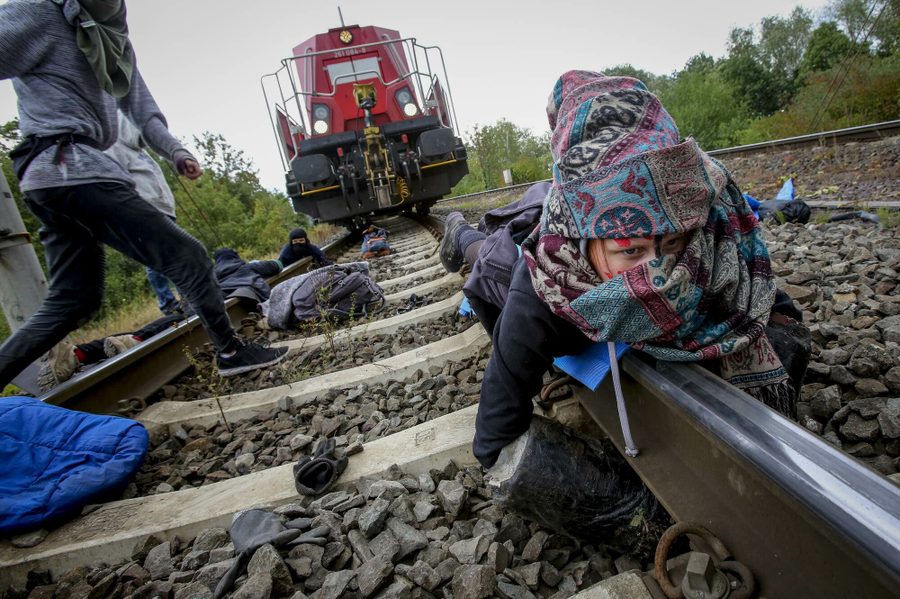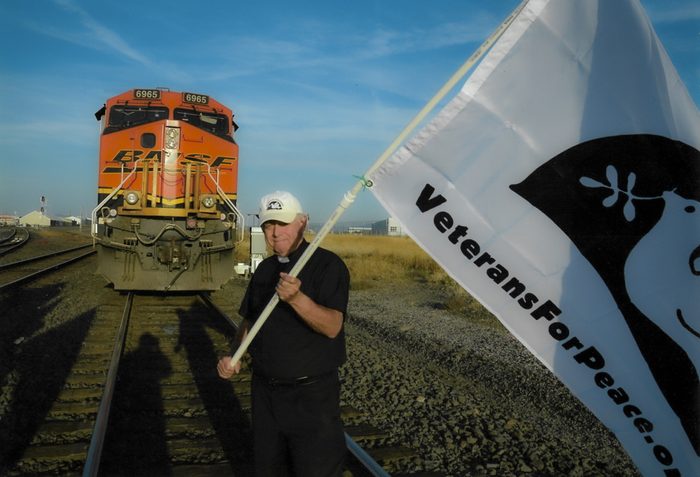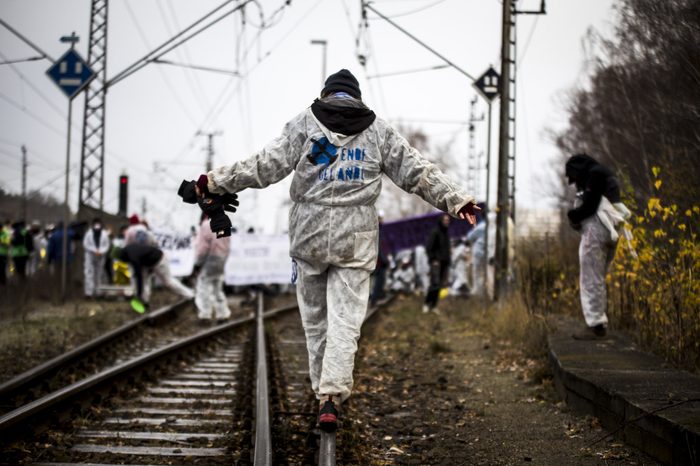How Far Would You Go to Stop Climate Change?
A landmark legal victory opens the door to direct action.
Jack McCordick

On a balmy afternoon in late September of 2016 — then the hottest year on record — a 76-year-old retired Presbyterian minister named George Taylor and some two dozen fellow residents of Spokane, Wash., stopped along a stretch of road that abuts a major set of train tracks coming into the city. Ignoring “No Trespassing” signs, they crossed a stretch of grass and walked onto the middle of the tracks. In front of them stood the lead car of a freight train, idling under a clear blue sky. Behind it, dozens of jet-black, cylindrical train cars stretched toward the horizon. Taylor had studied them long enough to know exactly what they were carrying: crude oil.
By the time Taylor stepped onto the tracks, he had been an environmental activist for nearly two decades and had attended his share of peaceful marches and rallies. “I used to go to protests, and they were good. You’d listen to someone like Bill McKibben, and everyone would wring their hands and say, ‘Isn’t this awful!’” he says. “But all those measures still seemed to fall short of doing anything effective to mitigate climate change.”
Most of the group scattered off the tracks when officers from the Spokane police and the BNSF police (the railroad company’s private police force) arrived and began issuing arrest warnings. Only Taylor, along with two other septuagenarian Veterans for Peace, remained. Getting arrested — something Taylor had done six times before, in protest of the Vietnam and Iraq wars — had been their plan all along. They were charged with criminal trespass and the unlawful obstruction of a train, charges that could mean heavy fines and jail time. They planned to mount a joint defense with three other local activists — members of the Raging Grannies, an international activist network— who were arrested at the same spot a month earlier. The action was over in around an hour.
Over the past decade — and especially after the 2016 Dakota Access Pipeline protests in Standing Rock — activists and ordinary people across the United States have demonstrated an increasing willingness to break laws as the climate crisis worsens with little meaningful decarbonization. They have stood in front of trains, tampered with pipeline valves, blocked the entrances to coal plants, and occupied the banks that finance it all. For many, making it to court was the goal: with so little action from the country’s executive and legislative branches, they saw the courts as an essential setting to raise public awareness and build power.
Since 2009, more than 100 climate protesters in more than 30 criminal cases have attempted to use what has become known as the “climate necessity defense.” In a necessity defense, a defendant argues, in essence, that breaking the law is justified to promote a greater good when all other legal options have been exhausted. For protesters like Taylor, the hope is that winning necessity cases will draw attention to the crisis and embolden more disruptive and sustained resistance against fossil fuel infrastructure, turning an uncertain trickle into a powerful, transformative wave.
After a four-year setback under the Trump administration, climate activists began 2021 encouraged by Biden’s climate pledge for a “whole of government” approach. After a flurry of promising early executive actions, that momentum stalled. Over the past year and a half, the administration has opened up millions of acres of land for oil and gas and approved drilling permits faster than the Trump administration. It also defended major pipelines and other large fossil fuel infrastructure projects. The collapse of Build Back Better in December all but dashed those early hopes.
Another blow came June 30, when the Supreme Court handed down its decision in West Virginia v. EPA, which significantly curtailed the Environmental Protection Agency’s ability to regulate greenhouse gases. Ellen Sciales, a spokesperson for the Sunrise Movement, says, “A Supreme Court that sides with the fossil fuel industry instead of people is anti-life and it is broken, and our leaders are standing by while this illegitimate court is going on the offense.”
Climate movement attorney and literary scholar Ted Hamilton founded the Climate Defense Project in 2016 to support climate activists and promote the necessity defense. He says these recent developments contribute “to not just a sense that mainstream climate policy making has reached another dead end, but — in consonance with racial justice activists, reproductive rights activists, democracy activists — a sense within the climate activist world that institutional politics are really fundamentally broken at the national level.”
“With where things are headed with the climate and ecological crisis, I do think that there’s going to be more and more people who are willing to take that risk of going to jail and prison because these things are not being addressed,” says Christina See, a political strategy coordinator for Extinction Rebellion, a global environmental movement dedicated to nonviolent direct action.
Many are already coming to that conclusion. An April 2022 survey from the Yale Program on Climate Change Communication finds 28% of U.S. citizens would support an organization engaging in nonviolent civil disobedience “against corporate or government activities that make global warming worse.” Nearly one in five say they personally would engage in it.
For climate activists considering breaking the law, the climate necessity defense potentially offers a powerful tool. Yet, when George Taylor stepped onto the tracks in 2016, most trial judges were loath to even allow the defense to be argued in their courtrooms. At that point, only two groups of protesters had ever even been permitted by any U.S. judge to make the defense in front of a jury. Neither was acquitted.
Taylor wanted to be the first to succeed.
“I was prepared to go to jail,” Taylor says. “I didn’t have many financial resources, and I don’t know what I would have done with a heavy fine, but I was ready to take that risk.”

The necessity defense comes to the United States from the English common law tradition. Some early cases involved British maritime traders in the 1800s tossing cargo into the sea to avoid shipwreck. Over time, most U.S. states developed some variation of a four-prong test for juries to determine whether a lawbreaker should be acquitted by reason of necessity. In Washington, a defendant has to show they reasonably believed committing the crime was necessary to avoid a harm; the harm they tried to avoid was greater than the harm that resulted; they themselves didn’t bring about that harm by their lawbreaking; and they had no reasonable, legal alternative.
The vast majority of necessity cases involve immediate physical threats. But beginning in the 1970s, some activists attempted to make necessity defenses in civil disobedience cases and achieved some surprising victories in cases involving anti-apartheid, antiwar and anti-nuclear actions. But as the conservative legal movement began its half-century-long takeover of the U.S. judiciary, judges across the country became significantly less open to necessity defenses in civil disobedience cases.
“By the time we got to the late 2000s, there just hadn’t been a good track record of people using creative defenses” for civil disobedience, Hamilton says.
The first time a U.S. citizen tried to use the climate necessity defense came in 2009. Tim DeChristopher, a college student who had just finished his final exams, registered for an oil lease auction in Salt Lake City and won bids for thousands of acres of land worth more than $1.8 million. He had no intent to pay for them, and was charged with two felonies.
In his federal trial, DeChristopher submitted explanations of each element of the necessity defense, of the climate effects of oil drilling, of how civil disobedience produces social change, and of why breaking the law was his only option. Federal judges barred DeChristopher from offering the necessity defense in court, arguing that he had plenty of legal alternatives to effect change. DeChristopher was convicted and served a 21 month prison sentence.
“Especially after the DeChristopher case,” Hamilton says, “the consensus, even among people who are more friendly to these types of ideas, was that climate necessity defense was just not going to happen.”
That didn’t stop people from trying.

On June 26, 2017, three weeks after Donald Trump announced the U.S. withdrawal from the 2015 Paris climate accords, the first pre-trial motion hearing in the George Taylor case was held at 1:30 p.m. in Room 5 of the Public Safety Building, a drab, two-story courthouse just blocks from the Spokane River. The hearing — which included expert witness testimony — was meant to determine whether Judge Debra Hayes, a former prosecutor who says she is “not an activist judge,” would allow the defense to present a necessity argument at trial.
By this point, Taylor’s fellow defendants had all decided to take plea deals. A few had been spooked by the possibility that BNSF might sue for extensive civil damages. Others had family obligations that made them leery of a protracted legal battle or jail time.
Though Taylor faced the judge as the sole defendant, he certainly wasn’t alone. Dozens of local activists, students and supporters piled into the courtroom. A TV crew filmed in the back. “It was packed,” Taylor says. “Every seat was taken.”
The defense began by putting Steven Running on the stand. A burly man with a gravelly voice and a full head of white hair, Running is a climate scientist who co-authored a chapter of the 2007 Intergovernmental Panel on Climate Change report.
Sporting a slate gray short-sleeved button-down shirt, glasses and a gray and black tie, Running began to answer questions from Rachael Osborn, one of Taylor’s pro bono lawyers. As Running started speaking, Osborn remembers seeing Judge Hayes immediately perk up. “The judge was completely fascinated,” Osborn says. “She’s a Republican-appointed judge — most judges are in Spokane. But she got what we were trying to say.” The case certainly offered a change of pace from what Judge Hayes was used to. “One hour you’re talking about a shoplifting case, and the next you’re talking about the end of humanity,” Running remembers.
During a lengthy testimony full of charts and graphs, Running explained the consequences of the steep rise of carbon dioxide emissions over the past two centuries. He presented data showing that, in Washington State over the past half-century, average temperatures had gone up, snowmelt began earlier and large wildfires had become four or five times more frequent. He argued that, despite all this evidence, the Trump administration “would like to bring back and retain fossil fuel energy sources to the maximum extent possible.”
As Running spoke, Taylor watched Judge Hayes take copious notes. “I was listening to every word,” Judge Hayes remembers.
After almost an hour, Osborn asked Running to summarize his testimony. “If we take the ‘business as usual’ — which, what that means is literally just keep on doing what we’re doing — and that takes us onto the order of 10- or 12-degree Fahrenheit increase in temperatures, we don’t think we would have a stable functioning society worldwide at those temperatures,” Running said. “I’m not saying everybody would be dead, but I think there would be so much disruption worldwide of all societies that I think it would be absolute global chaos.”
Taylor’s next expert witness was Tom Hastings, a professor at Portland State University who studies nonviolent civil disobedience. In his testimony, Hastings defended Taylor’s actions as part of a venerable and vital American tradition. He referenced Why Civil Resistance Works, an oft-cited 2011 book that examined more than 300 cases of violent and nonviolent resistance campaigns around the globe and found that, more often than not, nonviolent civil resistance achieved its goals. Osborn asked Hastings whether civil disobedience could help mitigate climate change. “It’s our last best hope at this point,” he replied.
“I may well be back in that court, or another one, but not always as an expert witness, rather as a defendant,” Hastings wrote after the hearing. “I’d invite anyone to consider that.”
After the expert testimony, Judge Hayes addressed Running and Hastings. “I feel like I have been given a real basic education on global warming and the effects of the emissions, and a lot to think about,” she said. “Thank you.”
Two months later, Taylor returned for a second pre-trial hearing to testify on the fourth component of the necessity defense, the final prong on which many previous cases had foundered — whether he had exhausted all “reasonable, legal alternatives” before breaking the law.
Taylor, questioned by his attorney, Eric Christianson, listed all the ways he had previously tried to spur action on climate policy. He was a member of a local environmental group. He always voted for “green” candidates. He sent numerous letters and emails to his federal elected representatives and even spoke to each of them personally. He testified three times when the U.S. Army Corps of Engineers came to Spokane for hearings on statewide railroad safety issues. “Everything the environmental community seems to have tried isn’t working,” Taylor said. “The situation, if anything — in this past year or two — seems to have slowed down instead of sped up,” he added, alluding to the Trump administration’s dismantling of Obama-era policies. “And so we’re actually quite discouraged at this point.”
“One last time,” Christianson asked Taylor, “were there any other reasonable alternatives that you or your cohorts could come up with — other reasonable alternatives to just going out and stopping the trains?”
“At that moment in time, we felt there were no other reasonable alternatives,” Taylor replied. “There may have been, but in our minds, there were none, and this was the time to do it.”
At the end of the hearing, Judge Hayes gave Taylor a verbal commitment that he would be able to present a full necessity defense at trial. “I felt elated,” Taylor says. “I felt it had been worth all that planning and all that trouble. We’d accomplished what we set out to do, which was to get the necessity defense to a trial. … So far, so good.”

It wasn’t so simple. Soon after Judge Hayes released a written decision formally granting the necessity defense motion, the prosecutor’s office filed for a review with Superior Court Judge Harold Clarke, whom Osborn describes as “the most conservative judge in Spokane County.” Clarke reversed Judge Hayes’ ruling, arguing Taylor misinterpreted a “reasonable” legal alternative to be “synonymous with effective.”
Taylor’s legal team appealed, but in June 2020, an appeals court affirmed Clarke’s reversal. In a 2 – 1 decision, the court ruled “the necessity defense does not apply to persons who engage in civil disobedience by intentionally violating constitutional laws,” and “there are always reasonable legal alternatives to disobeying constitutional laws.”
Taylor and his legal team — which had logged hundreds of hours of pro bono work — began to fear not only that Taylor would have to face a jury without his only plausible defense, but the appeals ruling could set a precedent that would bar future protesters in the state from even attempting the necessity defense.
There was, however, one bright spot. In a thundering dissent, Court of Appeals Judge George Fearing wrote that by “affirming the superior court, this court ignores Washington precedent, creates new law, emasculates the meaning of the word ‘reasonable,’ endangers the survival of the necessity defense, diminishes a patriotic tradition, overlooks political reality, rejects the moral worth of civil disobedience, discounts the universal need for honorable lawbreaking, shuts the court’s ears to the disaffected, usurps the role of the jury and denies George Taylor the right to a fair trial.” The dissent gave Taylor’s team some hope, and they appealed to the State Supreme Court, which agreed to hear the case in January 2021.
Throughout oral arguments, the justices appeared generally receptive to Taylor’s case but seemed worried about what a ruling in his favor might unleash. “Let me ask you how far this goes,” Chief Justice Steven González asked Todd Maybrown, a criminal defense attorney who had joined Taylor’s legal team. “If, instead of blocking the tracks, somebody blows up a train bridge so the train can’t go by, is the defense still available?”
Maybrown artfully deflected: The case before the court was simply about Taylor’s constitutional right to present a complete defense. It should be a jury in Spokane that gets to consider all of the facts. Any hypothetical scenario was irrelevant.
Oral arguments finished in less than an hour. All Taylor and his lawyers could do was wait.
In summer 2021, as Taylor awaited the decision, the Pacific Northwest was hit with a one-in-a-thousand year heat wave that killed hundreds of people and boiled more than one billion sea creatures. Two weeks after temperatures in Spokane hit 109 — an all-time high — the court handed down its ruling.
In a 7 – 0 decision, the court ruled Taylor was entitled to present the necessity defense at trial. “While there are always alternatives in the abstract, an alternative that has repeatedly failed when attempted is not a reasonable alternative,” wrote Justice Susan Owens. It was the first full opinion from the highest court of any state to endorse the climate necessity defense. In addition to establishing a crucial precedent, the decision remanded Taylor’s case back down to Judge Hayes.
The trial date was set for mid-December, and Taylor’s lawyers began reaching out to potential expert witnesses.
On November 1, however, Taylor got an email from one of his attorneys. The prosecutor’s office had emailed her a single sentence, which Taylor can still recite nearly verbatim: “At the request of the BNSF Railroad Company, the prosecutor has filed a writ of dismissal that all charges on Reverend George Taylor, case number 6Z011770117975, be dropped with prejudice.” The charges against him could never be raised again.
“I felt like all the air in my balloon had kind of been let out,” Taylor says.
After five years of hearings, testimonies, legal filings, briefings and appeals — and one of the biggest legal victories anywhere in the country for climate activists — Taylor learned he would never get a chance to make his case in front of a jury of his peers.
During the 14 years American activists have promoted the climate necessity defense, their country elected a climate denier president and became the world’s largest producer of crude oil and natural gas. Global concentrations of carbon dioxide continued to tick steadily up, from 385 parts per million in 2008 to more than 415 this year. Coal and oil trains continued to rumble through downtown Spokane every day.
Meanwhile, Ted Hamilton says he’s seen “significant but not transformative progress” in promoting the climate necessity defense. There have been bench acquittals, hung juries, and other instances in which prosecutors drop necessity cases before they go to trial. In a few cases, judges and prosecutors have even declared themselves openly sympathetic with the goals of defendants.
To this day, however, no climate protester has been fully acquitted by a jury by reason of necessity. Hamilton admits the defense is “still not a widely available defense and isn’t universally recognized.” He still thinks most climate protesters face fairly steep odds of getting the defense in front of a jury, especially in red states where conservatives have successfully stacked the judiciary with right-wing ideologues.
In September 2021, a group of protesters arrested for blocking a train heading toward New England’s last major coal-fired power plant were barred from presenting the necessity defense, even as they cited Taylor’s victory. “[The New Hampshire judge] was very clear that he thought symbolic protest was fine, but as soon as you start messing with commerce, you’re in trouble,” says Marla Marcum, who directs the Climate Disobedience Center and provided support to the activists. Four of the five were found guilty on multiple trespassing charges in March.
“It’s not a silver bullet,” Hamilton says. “You need to just keep throwing it against the wall, and the more successes you get, the more attempts you’ll get. … This is the way the law changes. These things take time.”
But time is not on the climate movement’s side.
In February, Taylor gave a guest sermon at the Unitarian Universalist Church of Spokane. He retold his five year legal saga, from his decision to get arrested, to the district court hearings and the rounds of appeals, to the Supreme Court victory, to the dropped charges. Then he turned to the future.
“If someone planted a time bomb in your home, you are entitled to dismantle it,” Taylor said. “Those who deny the immediacy of this metaphor are either ignorant of climate science, or unwilling to understand its implications.”
He concluded: “We need to start disrupting and destroying fossil fuel infrastructure. It is that dangerous. … It’s the time bomb that needs to be dismantled.”
At 82, Taylor is still trying to figure out what he and other activists can do — in the courts, in the streets, in the maw of fossil fuel infrastructure. “Unless we come to grips with it and face this crisis, future generations will have the right to ask each of us, ‘What did you do to mitigate this terrible problem that happened under your watch?’” he says, thinking of his two grandchildren. “What did you do?”
Jack McCordick is a reporter-researcher at The New
Republic. He lives in New York.






